ę November 2006 | Main | January 2007 Ľ
December 29, 2006
Become the paint
or how to get the stuck tops off old tubes of paint
Well you heat the top so it expands a bit, thus easing the bound situation. And where better to heat the top than in the recently boiled water of a mug of coffee?
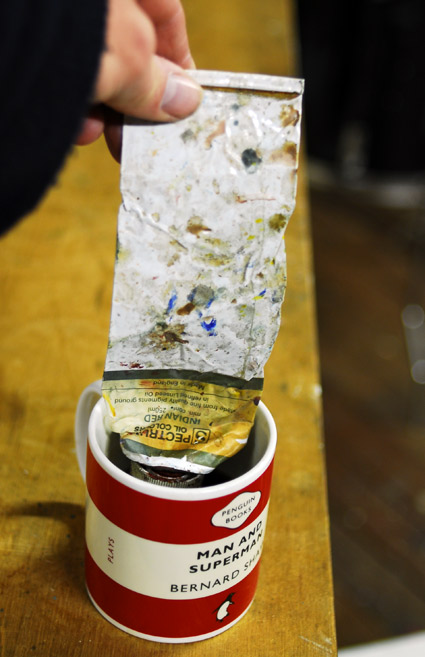
To take William Coldstreamís doctrine* to its illogical conclusions, after dipping the tops of old paint tubes in my coffee, to enable said egress, I ingest the dissolved and dilute remains of everything from linseed oil to Indian Red.
This I feel will produce a more honest and integrated approach to the painting, if not a nasty aftertaste.
*to paint the bucket you have to become the bucket and make marks the bucket would make.
Posted by john at 01:42 PM | Comments (0)
December 28, 2006
Plastering like Painting
Plastering - amazing business. There it is all smooth and peachy on the wall, but how does it get there? It starts off as a thin gloopy slippery sloppy liquid Ė you pour it out of the mixing bucket onto the spot board.

How the hell díyou get it onto a vertical wall? Let alone all smooth and peachy. Try it Ė itís impossible.
Several years ago, when I was working on my first house:
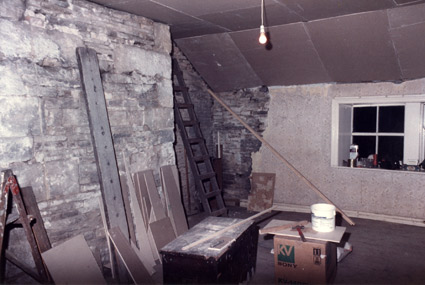
Big Eddie was doing some plastering for me. So I asked him how it was done and would he show me the dark mysteries of mastering The Dark Art of Sticky Gypsum?
Like painting, at least: oil painting, plaster isnít a single-point success. You donít start at the top of the wall and work down leaving a peachy smoothness in your path.
It happens in stages and has to be worked when wet, you canít set up a whole wall then go off for lunch and a browse round the second-hand book shop and expect to get anything like a smooth surface when you return a couple of hours later.
With the plaster you have to get a whole lot of schlop onto the wall as best you can, balancing runny liquids on a flat trowel. With painting it isnít such a balancing act to get a lot of paint up and onto the panel, but it takes a while because you are dealing with various hues and tones.
Then, like plaster, you work it while itís wet, and begin to get the colours and tones interacting in an exciting fashion.
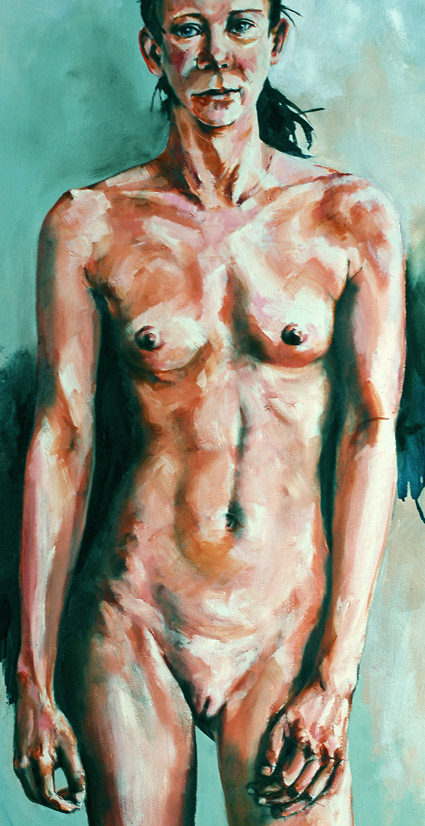
And at no time, with plastering or painting, when youíre levering the wet and slippery onto the vertical do you attempt to get it ďrightĒ. Itís a matter of timing and graft. The smoothness doesnít come out of the bucket it comes from your arm and the sweat on your brow via the edge of the trowel. The form doesnít come straight off the palette, it comes from knowing where to place the tones and hues and how to get them to throw the whole into such chaos that the brain, complex squish that it is, reads them as three dimensions.
And plastering, like painting is an art that gets better the more you do it, the more you do the more you begin to understand the medium and master the slippery tricky nature of laminar flow and fluid dynamics.
Posted by john at 06:43 PM | Comments (0)
Art and Illusion
Art is all about illusion, whether itís the illusion of three dimensional space on a flat surface, the illusion of reality in a sculpture, or the illusion of an emotion in an abstract piece. Whichever way you look at it, art is illusion.
ďArt is a lie that makes us realise the truthĒ said Picasso.
Artists are therefore illusionists or to put it another way: magicians. Make a mark on a surface and itís SHOWTIME!
If a book drops unseen in a jungle can it be read? A picture not seen can be said not to exist. Pictures exist to be looked at, like cats [except SchrŲdingerís, obviously].
So we pull on the spangly tights as we pick up the brushes and draw aside the curtain of our stage there miracles to perform. Itís not so much a case of LOOK AT ME! as: LOOK AT WHAT IíVE DONE!
If no-one sees your work, well what then? Does it exist?
Posted by john at 04:44 PM | Comments (0)
December 20, 2006
Sneaking up on Drawing - chapter 2
More lessons in the magic and mystery of getting those tricky dimensions reduced in number from three to two.
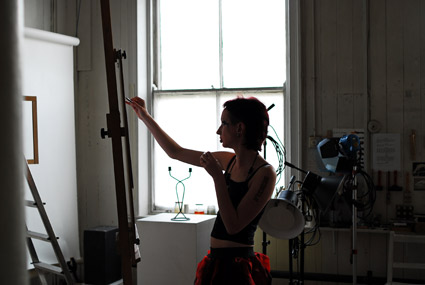
Emily spent the day trying hard not to draw a collection of odd things. But not just any collection of odd things, a very specific collection of odd things, arranged in a certain order and relationship to each other so as to possess critical attributes of space and distance. [honest]
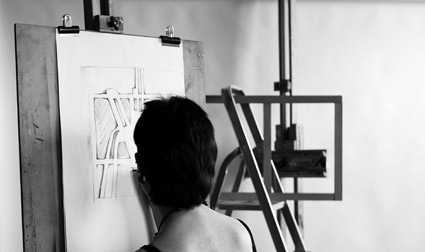
And she did a damn fine job of it too.
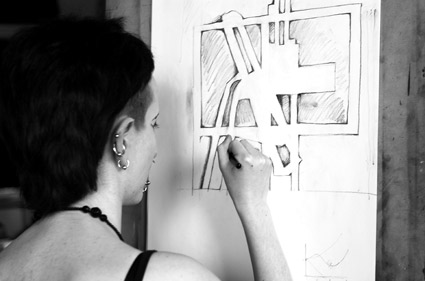
The general idea is to improve observation skills by spending some time contemplating the space around what you are looking at. Then, rather than draw the aforementioned collection of odd things, you draw the shapes of the spaces around and in and amongst them, thereby creating a drawing of said things without actually drawing any of them.
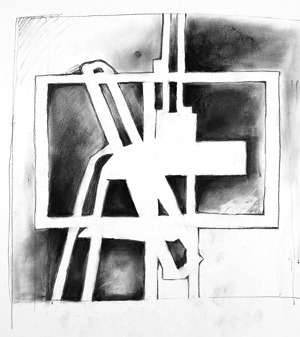
Emily makes it look easy because she is a good draughtsman - no, now is not the time to enter into the gender debate Ė you know what I mean.
Posted by john at 09:01 PM | Comments (0)
December 18, 2006
One thing leads to another
Well, I donít know, the palette is clean for six months or more then, bus like, I pull out the panels.
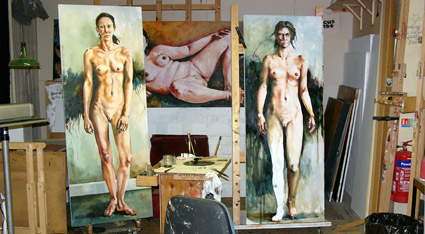
Still only fiddling with the backgrounds though, not getting under the skin yet. Thatís when I need the skin in front of me, in the flesh, living and breathing and kicking the bright falling light about.
Posted by john at 06:51 PM | Comments (0)
December 17, 2006
Playing in the shadows
When I stopped painting this picture I left the figure hovering in space, the figure wasn't grounded. I wonder if this was a reaction to the model leaving somewhat precipitously, well not leaving so much as not returning.
Anyway, yesterday, with all the talk of Uglow, I felt it time to place the figure, so I got the lids off some paint and worked up a background and, more important perhaps, a floor:
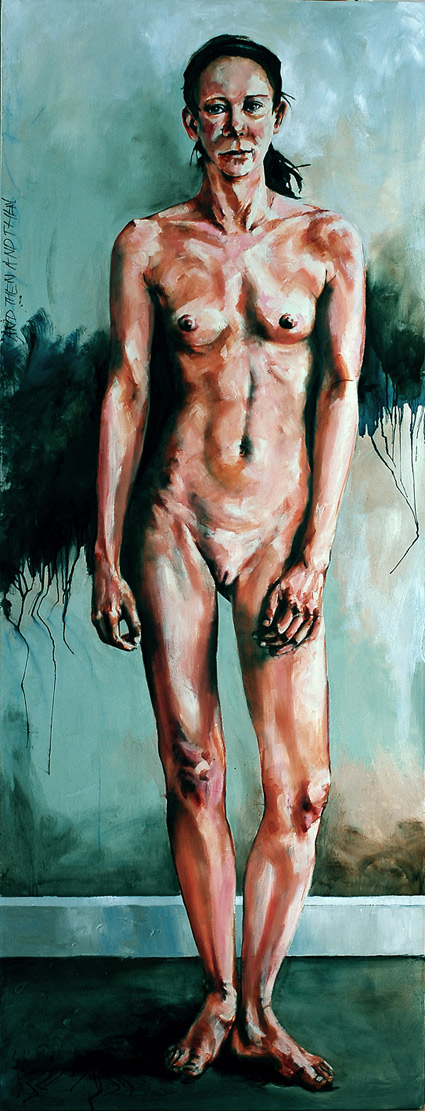
Posted by john at 10:33 AM | Comments (0)
December 16, 2006
a muse revisited
it's been a while,
but there's some paint on the palette again.
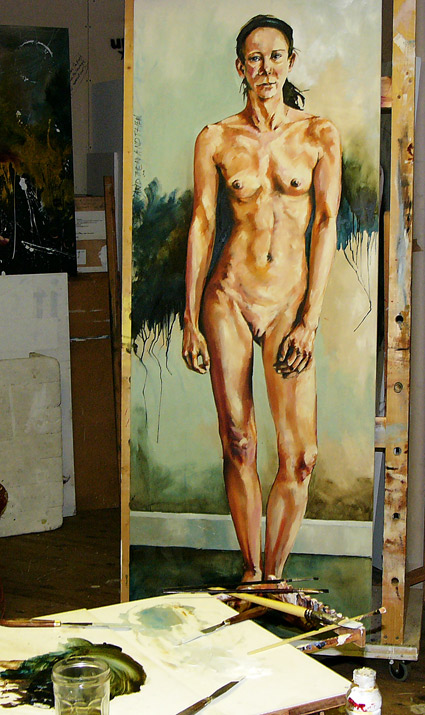
Posted by john at 11:34 PM | Comments (0)
Why exhibit when I could be painting?
A sentiment expressed by Euan Uglow. "Euan only wanted to paint, and felt he couldn't waste time on exhibitions of his work," said Will Darby, his dealer for thirty years, in an article in the Guardian.
I know the feeling, exhibitions are very time-consuming. But itís hard to paint and not be seen. For me one of the reasons to paint is to express a deep emotion and, somewhat selfishly maybe, I want people to see this emotion and perhaps understand me a little.
Nobody understood Uglow, this didn't seem to bother him. He seldom gave interviews, and even his close friends donít really know what went on in the painterís mind. His paintings, for those who arenít familiar with them, are hard analytical observations of life.
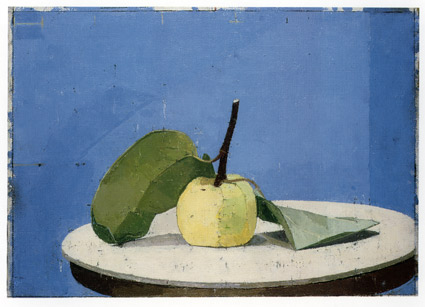
Quince, 1998, oil on canvas, 254mm x 356mm
His critics have accused him of being cold and passionless, his colleagues say he was so emotional he needed to create a system to contain his feelings. I can relate to that.
When I was at art college in Liverpool, in the seventies, Uglow won the John Moores Prize with ďNude, 12 vertical positions from the eyeĒ. To say it moved me would be an understatement, it had a profound effect on me and Iíve been haunted by the painting ever since.
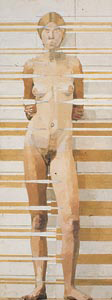
Nude, 12 vertical positions from the eye, 1967, oil on panel, 2438mm x 914mm
I have, over the years, tried to paint a standing figure of such power. Many examples of both paintings and drawings have appeared on these pages, more can be seen on my main site. The nearest I have come, I feel, is this:
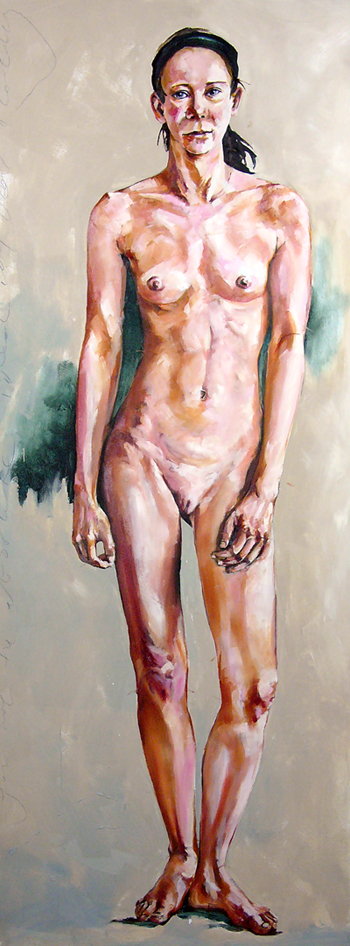
Standing figure VIII, 2005, oil on panel, 1980mm x 760mm
When asked why he painted Uglow once replied: ďIím trying to find out why a subject does look so marvellous, and trying to make that sensation manifest on a flat surface.Ē
I feel moved to paint again.
Posted by john at 01:36 PM | Comments (0)
December 15, 2006
CLICK!
A hundred and twenty fifth of a second. Not long, really in the grand scheme of things. Though it is, possibly, to our lifetime as we are to the history of the planet.
Photography - been interested in it since Uncle Wally gave me an old Voigtlander bellows camera, nearly 35 years ago:
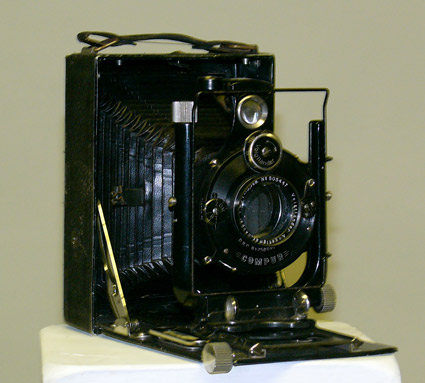
the first camera
I summoned the family to sit for me, this is probably from my first roll of film:
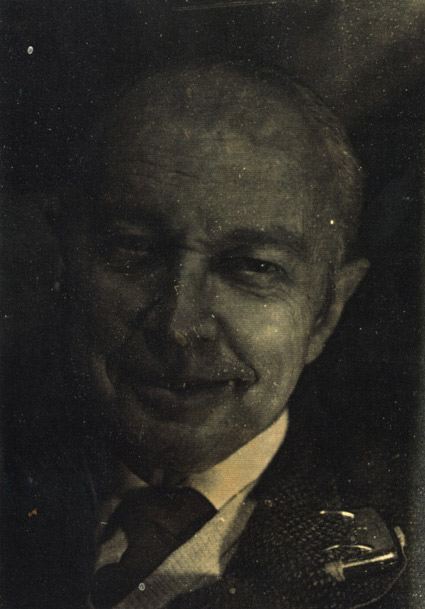
my father
A tripod would be essential in those days but for this, if I remember, I just sat the camera on a table and hoped. There were two backs to the camera, one was the viewfinder - a ground glass screen upon which you could see the image, upside-down. Then, when you were happy with the composition and the focus, achieved by sliding the bellows in and out:
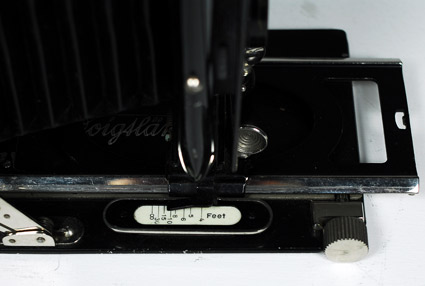
You took the viewer-back off and slid the film-back on, with its roll of Ilford 120, 12 exposure, film. Then you set the aperture and the shutter speed, closed the shutter, slid out the front of the back, primed the shutter and CLICK! Instamatic it wasn't, but it was sophisticated. There are little knurled knobs to move the lens up and down or side to side, respective to the film-plane, to adjust the parallax. There is even a little spirit level to make sure everything is, well, level.
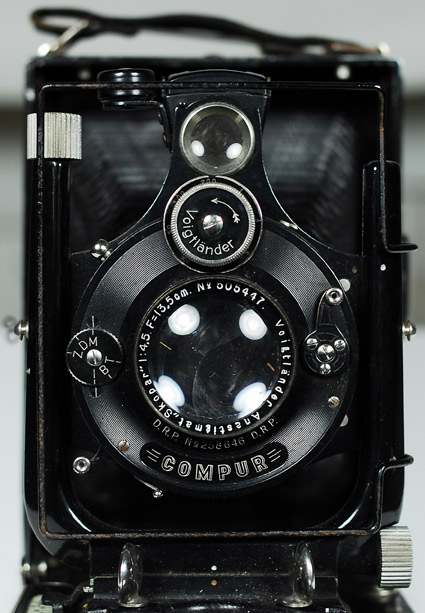
Iíve always been more interested in photographing people than objects, just as I prefer to paint people not still-lifes.
I think a photograph should be something else than just a record of a time and place. Though if the time and place is significant then that will suffice:
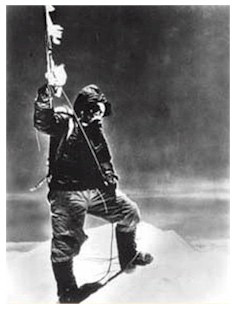
Tenzing Norgay, on the summit of Everest, Photo: Sir Edmund Hilary
and now, to span the time, twixt the first and the last, hereís one of my most recent photographs:
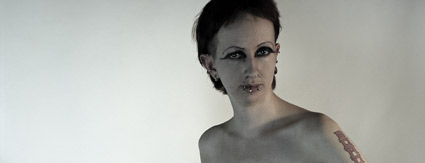
Emily
The photographs of the Voigtlander were taken with a Nikon D200, I must get a roll of 120 film and take some pictures of the Nikon with the Voigtlander.
Posted by john at 11:28 AM | Comments (0)
December 13, 2006
Not the bones or the stones, please, not yet.
What should I choose? asked Rowan, currently studying for his GCSE Art examinations, as we sat round eating Martinís choice spaghetti. Itís always a hard question.
His main area of choice was Natural Forms. I cringed. Natural Forms hides a degree of blandness that knows no bounds and if thereís one thing thatís hard to paint or draw itís blandness.
Oh, sure, there are professional artists whose skills are honed to such a degree that the thought of painting a white egg on a white tablecloth against a white wall creates a challenge which is hard to resist. But their cause is not ours and it's certainly not a suitable subject for a school art room.
Stones, bones, leaves, feathers and twigs might look interesting to the eye, but thatís because weíve got 125 million pixels [ok photo-receptors] in each eye and highly developed interpretive software in our heads which fill in the gaps for us. And the gaps are many, as you will discover if you choose to go down this route.
Half the battle of producing a good painting [or drawing] is choosing the right thing to paint. Some things are good to paint, some things arenít. Choose carefully.
Personally I go with fruit, if for no other reason that if things donít go so well you can eat it. Not just any fruit mind you, in the world of fruit there are many pitfalls. Thereís fruit thatís good to draw and fruit thatís hard to draw. [see previous post]
Basically the only fruit worth a fig are lemons and pears, for the same reason that Bart Simpson has big spiky hair. Matt Groening drew his original characters with a distinctive silhouette so they would be easily recognisable.

Which is good because recognising is what we do best. So long as weíve got some big clues.
What is this?
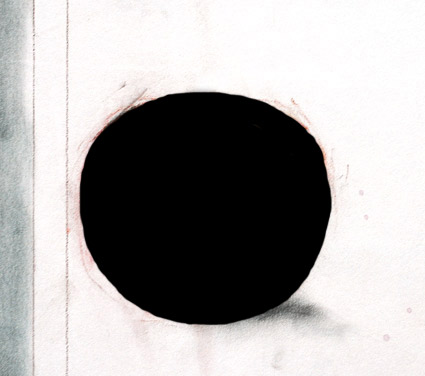
It could be an orange, a grapefruit, an apple, a grape, a cherry, a blueberry to name but a few.
And this?
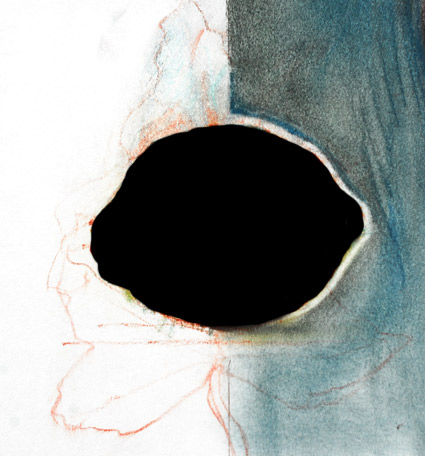
answers at the bottom of the post
So before you get into textures and form and shading and surface pattern, donít make your task any more difficult than it need be, consider the shape.
answers:
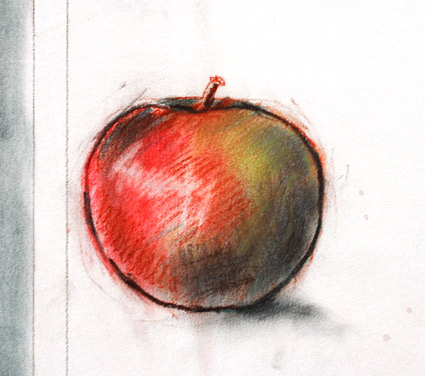
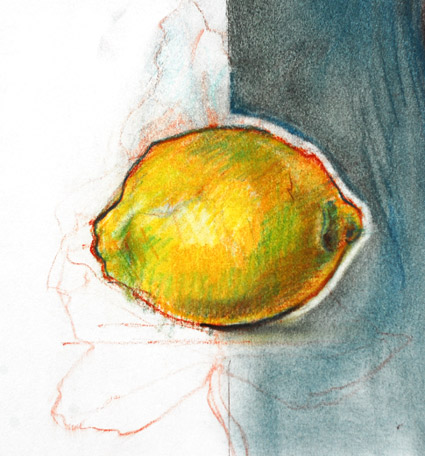
Posted by john at 11:22 PM | Comments (1)
December 11, 2006
When does art stop being art?
Where do installations go when they are uninstalled?
Upstairs.
Posing the question is it still art when itís stacked up in storage?
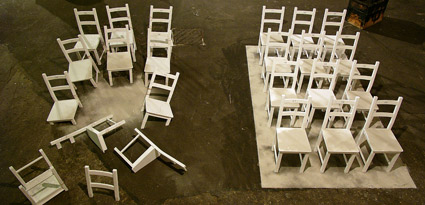
Book of Common Prayer, wood, copper, plaster
The paintings are still paintings when theyíre stored in the racks, thatís undeniable.
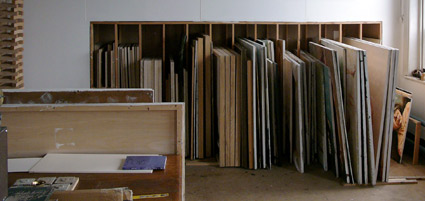
But the chairs? Surely now they are just a pile of stacked chairs?
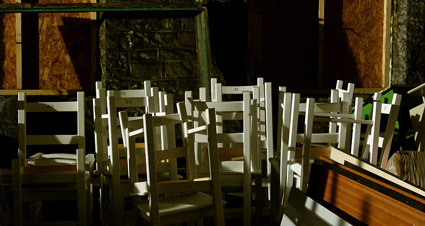
Posted by john at 10:53 PM | Comments (1)
December 09, 2006
chairs in the air
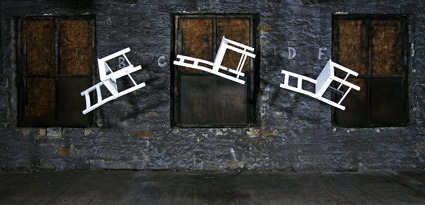
Posted by john at 09:48 PM | Comments (0)
December 06, 2006
Twenty years with a twisting torso
Processing some recent photographs, I realise Iíve been wrestling with a powerful image for twenty years now.
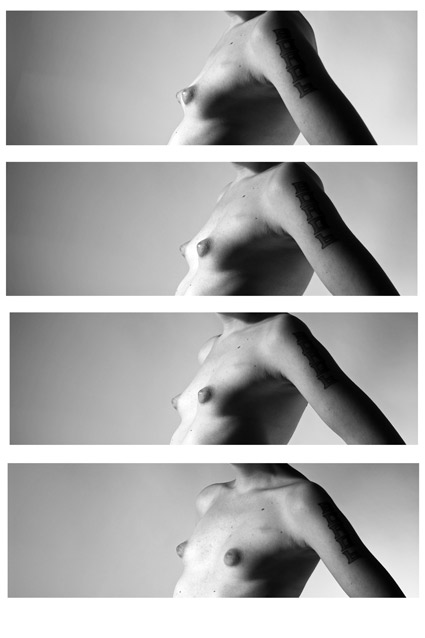
digital print, 420mm x 290mm, 2006
A twisting torso. Iíve photographed it, drawn it and painted it. Itís been my letterhead until recently, and the banner of my main website.
People have bought the drawings, people have bought the paintings, all in all itís been a happy partnership.
Why a twisting torso? Well itís just so powerful, it seems to have such potential, such beauty and strength.
It all started in 1986 when I was working with a dancer called Ali. I did a series of drawings of her twisting, concentrating on the arms and torso. I was also particularly partial to the extended landscape proportions of the composition.
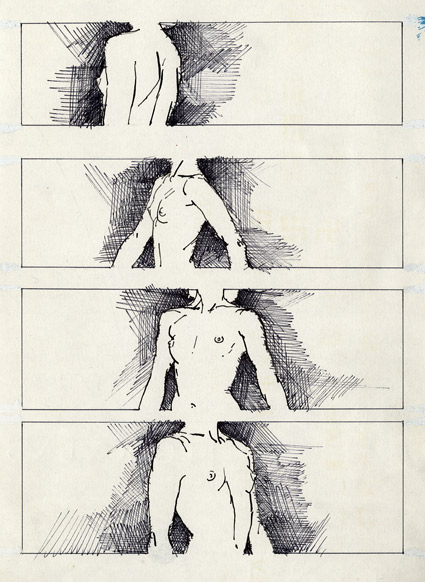
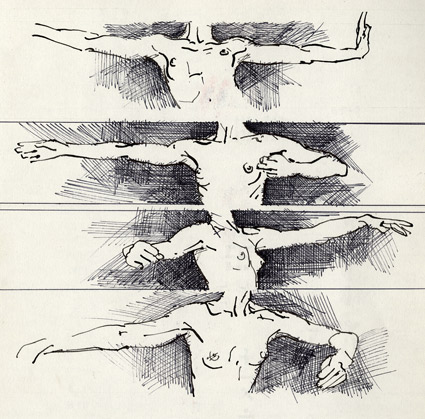
Ink on paper, 297mm x 210mm, 1986
The small ink drawings progressed to larger charcoal drawings

charcoal on paper, 300mm x 980mm, 1988
and finally to oil paint.
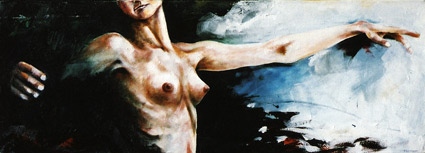
oil on canvas, 380mm x 980mm, 1994 - 1998
Posted by john at 09:15 PM | Comments (0)
It's that time of year again
It's that time of year when people with a creative flair get asked to translate the seasonal traditions onto two dimensional [folding] objects.
I am no exception, except that I want to go beyond the recent acquisitive traditions and dig about in older ones, namely:
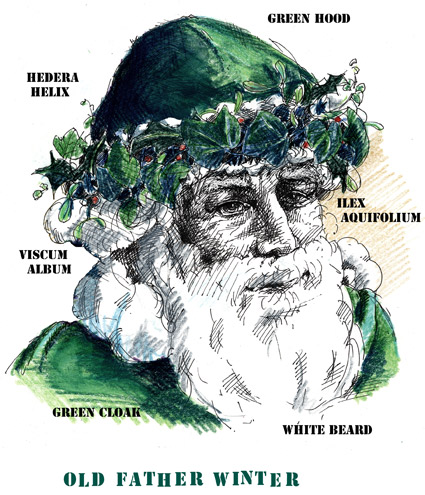
[with apologies to Larry Rivers]
During Yuletide, in the mid-winter solstice, when the nights were at their longest, and the cold pinched you to your bones, Old Father Winter, or as he was sometimes called: King Frost, would offer to lift your spirits.
Wearing a long green, fur-lined, hooded cloak and a wreath of ivy, holly and mistletoe, Old Father Winter would call at your house where you would ply him with warmth, hot food and good ale. The idea being that if you were kind to King Frost the winter would be kind to you and your family.
As the Christian myths spread through England, Old Father Winter gradually became Father Christmas, who had nothing to do with the giving of presents, or children, or wearing red raiment - we have Coca Cola to thank for all that.
Posted by john at 12:49 PM | Comments (0)
December 05, 2006
Just one, Tony?
Fellow artist Tony Chisholm, who is himself a great believer in drawing, has a plan. Well I hope he has a plan. Iím sure he has a plan. Heís sent me a luggage label and asked me to do a drawing on it. I imagine he has sent these out to other artists. I hope heís sent these out to other artists. Iím sure heís sent them out to other artists.

But he only sent ONE luggage label. Aaah! A drawing, straight from the hip, Iíve got to get it to work first go, no second chance. I wonder if this unique panic is part of Tonyís project?
Result of one off, single use, one time, luggage label: itís sitting on my desk.
Posted by john at 04:08 PM | Comments (0)
December 04, 2006
from pen and ink to reality
From the first drawings, in the post below, I got:
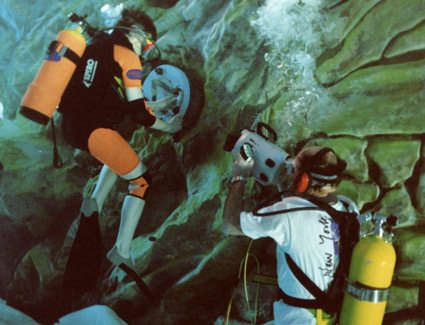
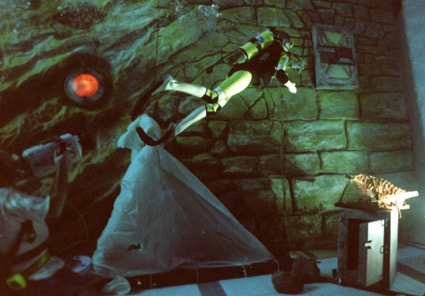
Get Wet, Scottish Television for ITV
and from the second drawings I get:


I must say there is something extremely pleasing about drawings taking shape in three dimensions. And the better you work things out in two dimensions the better the final things turn out.
So be it painting, sculpture, film, television design or dance, start with drawing. It can capture both detail and passion, what other medium can do that so easily?
Posted by john at 11:09 PM | Comments (0)
December 03, 2006
Narrative Expressionists talk about MAXIMALISM
Follow this link to see and hear the Narrative Expressionists talking about their recent shit hoe, I mean sit ho, no: hit show - that's the one.
Posted by john at 11:48 PM | Comments (0)
December 02, 2006
pen and ink
An ability to visualise things in three dimensions and then to draw them has helped me in many things,
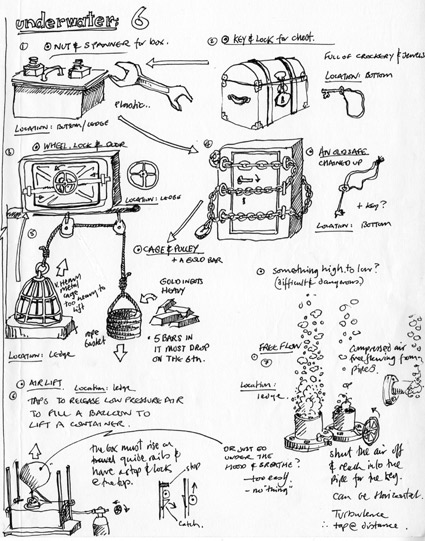
from drawing out TV games

to the construction details of a timber storm porch:
Posted by john at 05:58 PM | Comments (0)